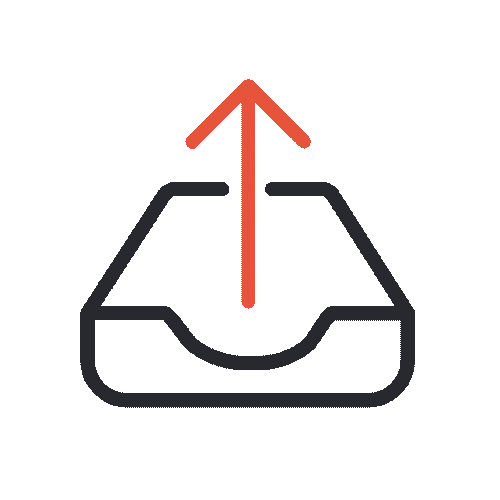Click Depth - Why and How it matters for a Website’s pagination and SEO
9 mins read.

In this article, we will learn how to implement website pagination in a 300 pages website. We will learn this in a way such that it will help in website SEO and achieve rankings.
A lot has been written on on-page SEO factors and how they affect search engine rankings.
Unfortunately, not every article covering on-page SEO factors lists Click Depth or Page Depth as a ranking factor.
In fact, John Muller (Webmaster Trend Analyst at Google) has himself described Click depth as an important ranking factor for SEO, even more important than a URL structure. As per Muller, Google considers the number of clicks from a homepage to your content as the most important ranking factor in terms of SEO.
In this article, we will understand the concept of Click Depth in SEO and how it influences internal linking, pagination, and crawl budget of your website.
Let’s dive in!
The term ‘Click Depth” describes the number of clicks needed from the homepage of your website to navigate to the other page.
For instance, the page clicked from your homepage has a click-depth of one.
In Google eyes, a website homepage is considered as a cornerstone material whereas every other page is considered as an essential material for SEO. Therefore, it should be your goal to make it easy for the users to navigate to the important content of your website from the homepage.
To make you understand how exactly does the click depth of a home page affect search rankings, let’s take an example of a 300-page website.
Imagine having a site with pagination from 1……300. For the purpose of this example, let’s assume they are blog posts with unique content. Here page number 1 is the Home page of the website and 300 is the last page of the website.
Now assume that the site consists of pagination where these pages are connected to a simple “next page” link at the bottom of each blog post. (See image attached below for better understanding)

From a human point of view, the pagination scheme is simple: you click the “next page” link and it takes you to the blog post number 2. You click on the “next page” one more time, it takes you to the number 3. To visit each and every page (say 300 times), you need to keep clicking on “next page” until you reach the page you want to visit. This looks like a holy grail of website pagination. Isn’t it?
From the crawler’s point of view, however, the site looks like this:
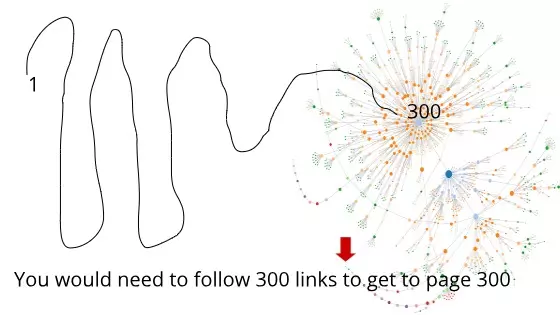
The image above illustrates the visual representation of a discovery path that a search engine crawler has to follow to crawl the whole 300-page website. The tail shown in the diagram is a “tunnel” which represents a long connected sequence of pages that the crawler has to crawl at a time. Note that, for each page, the “next page” link works like navigation to the consecutive page. For a user, it will take 299 clicks to go to the last page of the website. Google sees this as a click depth of 299 clicks, which is very bad for SEO since it offers a poor user experience for your website.
As per Google, the optimal click depth of the home page should not be greater than three clicks. This way the SE crawlers can easily find your website and your website can have a good crawl budget.
Here’s what Google’s John Muller has to say about the importance of Click Depth in SEO,
“What does matter for us ... is how easy it is to actually find the content. So especially if your homepage is generally the strongest page on your website, and from the homepage, it takes multiple clicks to actually get to one of these stores, then that makes it a lot harder for us to understand that these stores are actually pretty important."
“On the other hand, if it’s one click from the home page to one of these stores then that tells us that these stores are probably pretty relevant, and that probably we should be giving them a little bit of weight in the search results as well. So it’s more a matter of how many links you have to click through to actually get to that content rather than what the URL structure itself looks like.”
In essence: If a page needs more than 3 clicks to be reached, it’s performance will be considered as poorly to search engines. Hence, the pages that are deeper in your website silo’s will have issues to crawl as compared to the page of click depth one or two.
If the stats are to be believed, deep pages have a lower page rank because search engines are less likely to find them. Hence, crawling issues will be there. These pages are less likely to perform and rank as compared to the pages that are easily found from the home page.
In our example of the 300 pages website, the last page will have a click-depth of 300. The key takeaway from this kind of website pagination is that the traditional form of “next” and “previous” type of pagination is simply inefficient. Neither it is good for SEO, nor user experience.
If I were to make a list of problems that “Next” and “Previous” kind of pagination has, then here would be my key points:
So, how do we improve the click depth of a 300-page website?
The midpoint link pagination scheme is best for sites having a large number of pages. Here, pagination for the homepage looks like this:
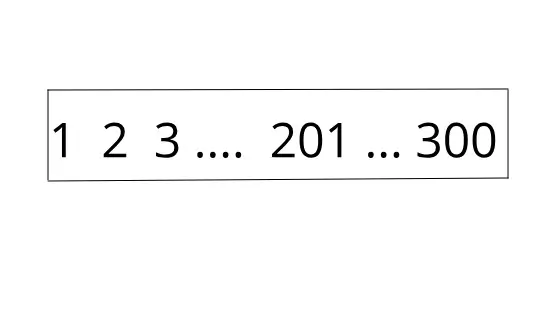
In the above image, 201 is the midpoint of the pagination and it lowers down the click depth from 300 to only a few clicks. What’s more, this scheme makes it possible for a crawler to navigate from any page to any other page in just a few steps.
Here’s the crawl chart for the Midpoint pagination strategy:
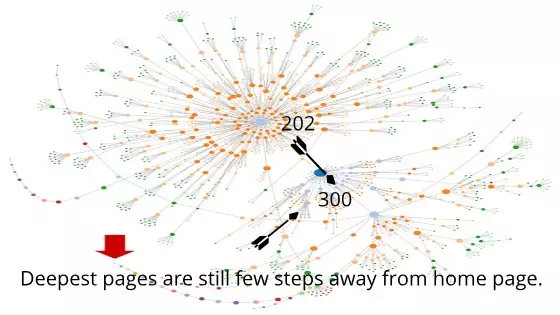
Notice how easily your user will be able to go to the last page of your website from page no. 201. This leads us to an incredible level of crawlability improvement as compared to the previous “next” and “previous” pagination scheme.
If a website (or Homepage) has a poor Click Depth then it can adversely affect search engine rankings.
The reason is simple: Google will not crawl the pages that are linked far away from the homepage. As a result, these pages won’t make their way to index. This will impact the rankings as there is little to no traffic on the pages.
The relationship between Click Depth and Page Rank is directly related as both of them are highly important to evaluate a page’s importance. The Page Rank algorithm does this by counting the quality and number of links to the page. On the other hand, Click Depth does this by automatically influencing the Page Rank depending on the number of clicks taken by the google bot to find the deep-linked pages from the website homepage.
So, how do we improve the Page Rank of the 300-page website?
The answer to this question lies in the internal linking graph optimization scheme. Your website, irrespective of the number of pages, can be optimized for Page Rank by internally linking the most important pages of your website.
Kevin Indig, VP SEO & content at G2.com, has written a really awesome article on the internal linking graph optimization scheme of a website that has 1000+ pages. Kevin’s article illustrates a TIPR model that dives deep in a robin-hood fashion to improve the page rank of poor pages of a website by linking them internally from stronger pages.
To improve the click depth of a website, all you need to do is to make all your pages accessible within three to four clicks from the homepage.
For starters, it can be done by visualizing your website as a tree graph to understand the overall structure of the website. (See the image attached below for reference)
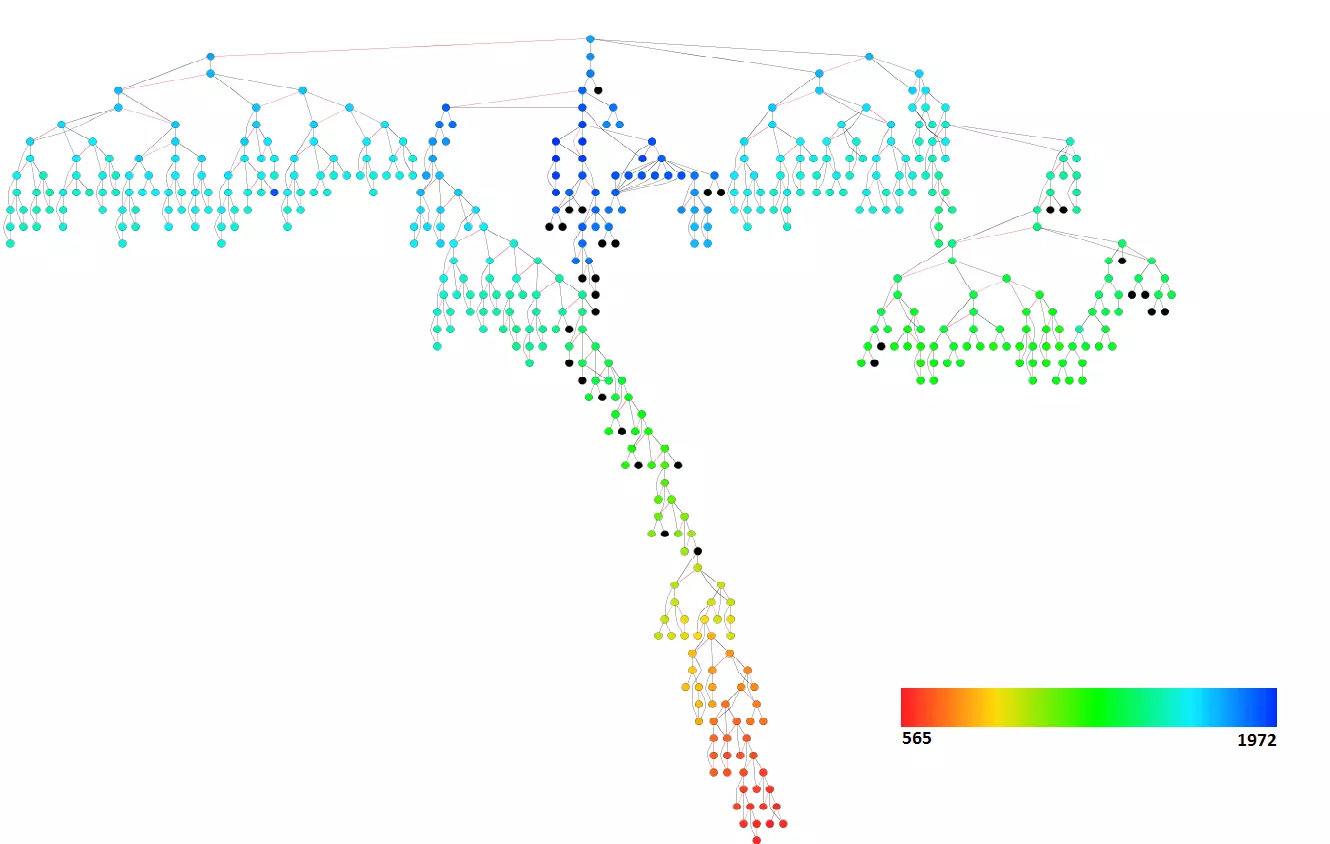
Notice how efficient it becomes to understand the website structure if we visualize the tree graph and put it on a paper. In large websites, you can improve the Click Depth by internally linking the poorly performed pages to the useful pages.
Internal linking improves your website’s Click Depth by:
Apart from internal linking, other strategies to improve the click depth of a website include:
Click depth (also referred to as Page depth sometimes) should be a key consideration while designing pagination for a website with a large structure. With the right approach, SEO can get the most out of Googlebot’s crawl budget, thereby improving the visibility of the site’s content.
Is there any other way to improve CLick Depth of a large website? Let me know in the comment section.
